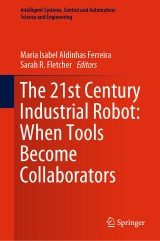Details

The 21st Century Industrial Robot: When Tools Become Collaborators
Intelligent Systems, Control and Automation: Science and Engineering, Band 81
|
149,79 € |
|
| Verlag: | Springer |
| Format: | |
| Veröffentl.: | 25.10.2021 |
| ISBN/EAN: | 9783030785130 |
| Sprache: | englisch |
| Anzahl Seiten: | 279 |
Dieses eBook enthält ein Wasserzeichen.
Beschreibungen
<div><p>This book aims to discuss the technical and ethical challenges posed by the present technological framework and to highlight the fundamental role played by human-centred design and human factors in the definition of robotic architectures for human–robot collaboration.</p>The book gives an updated overview of the most recent robotic technology, conceived and designed to collaborate with human beings in industrial working scenarios. The technological development of robotics over the last years and the fast evolution of AI, machine learning and IoT have paved the way for applications that extend far beyond the typical use of robots performing repetitive tasks in exclusive spaces. In this new technological paradigm that is expected to drive the robotics market in the coming years, robots and workers will coexist in the same workplace, sharing not only this lived space, but also the roles and functions inherent to a process of production, merging the benefits of automated and manualperforming. However, having robots cooperating in real time with workers, responding in a physical, psychological and social adequate way, requires a human-centred design that not only calls for high safety standards regulating the quality of human–robot interaction, but also demands the robot's fine-grained perception and awareness of the dynamics of its surrounding environment, namely the behaviours of their human peers—their expected actions/responses—fostering the necessary collaborative efforts towards the accomplishment of the tasks to be executed.<p></p></div>
Chapter 1: On Human Condition.- Chapter 2: Human-Robot Collaboration in Industrial Environments.- Chapter 3: Managed Systems Approach to Commissioning Collaborative Industrial Robot Systems.- Chapter 4: Robot Inference of Human States: Performance and Transparency in Physical Collaboration.- Chapter 5: Human-Robot Collaboration using Visual Cues for Communication.- Chapter 6: Trust in Industrial Human-Robot Collaboration.- Chapter 7: Adapting Autonomy and Personalisation in Collaborative Human-Robot Systems.- Chapter 8: Designing Robot Assistance to Optimize Operator Acceptance.
<div><p>This book aims to discuss the technical and ethical challenges posed by the present technological framework and to highlight the fundamental role played by human-centred design and human factors in the definition of robotic architectures for human–robot collaboration.</p>The book gives an updated overview of the most recent robotic technology, conceived and designed to collaborate with human beings in industrial working scenarios. The technological development of robotics over the last years and the fast evolution of AI, machine learning and IoT have paved the way for applications that extend far beyond the typical use of robots performing repetitive tasks in exclusive spaces. In this new technological paradigm that is expected to drive the robotics market in the coming years, robots and workers will coexist in the same workplace, sharing not only this lived space, but also the roles and functions inherent to a process of production, merging the benefits of automated and manualperforming. However, having robots cooperating in real time with workers, responding in a physical, psychological and social adequate way, requires a human-centred design that not only calls for high safety standards regulating the quality of human–robot interaction, but also demands the robot's fine-grained perception and awareness of the dynamics of its surrounding environment, namely the behaviours of their human peers—their expected actions/responses—fostering the necessary collaborative efforts towards the accomplishment of the tasks to be executed.<p></p></div>
Addresses the ethical and societal questions raised by the new form of interaction between industrial robots and their social demands in what relates robot architecture and design Demonstrates that the industrial robot of the 21st century becomes a new type of social robot Presents the state of the art research on a substantial change in the essence and nature of the typical industrial robot


















